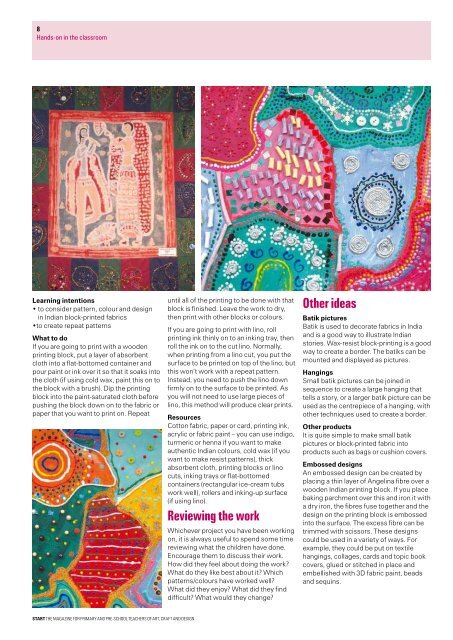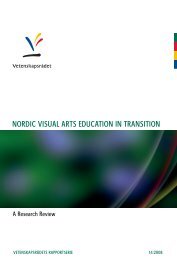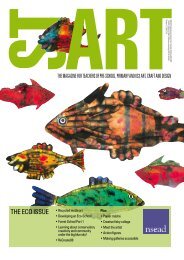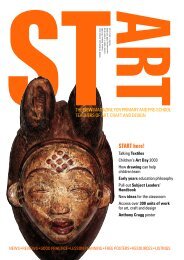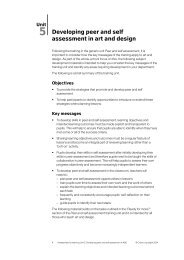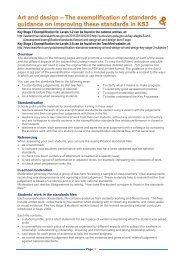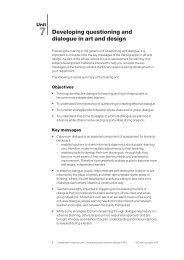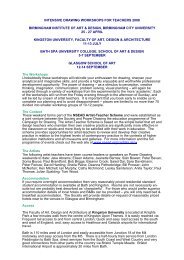textiles issue - The National Society for Education in Art and Design
textiles issue - The National Society for Education in Art and Design
textiles issue - The National Society for Education in Art and Design
You also want an ePaper? Increase the reach of your titles
YUMPU automatically turns print PDFs into web optimized ePapers that Google loves.
H<strong>and</strong>s-on <strong>in</strong> the classroomAfter-school clubIndian puppet-mak<strong>in</strong>g<strong>and</strong> Bollywoodfilm-mak<strong>in</strong>g!Learn<strong>in</strong>g <strong>in</strong>tentions• to consider pattern, colour <strong>and</strong> design<strong>in</strong> Indian block-pr<strong>in</strong>ted fabrics•to create repeat patternsWhat to doIf you are go<strong>in</strong>g to pr<strong>in</strong>t with a woodenpr<strong>in</strong>t<strong>in</strong>g block, put a layer of absorbentcloth <strong>in</strong>to a flat-bottomed conta<strong>in</strong>er <strong>and</strong>pour pa<strong>in</strong>t or <strong>in</strong>k over it so that it soaks <strong>in</strong>tothe cloth (if us<strong>in</strong>g cold wax, pa<strong>in</strong>t this on tothe block with a brush). Dip the pr<strong>in</strong>t<strong>in</strong>gblock <strong>in</strong>to the pa<strong>in</strong>t-saturated cloth be<strong>for</strong>epush<strong>in</strong>g the block down on to the fabric orpaper that you want to pr<strong>in</strong>t on. Repeatuntil all of the pr<strong>in</strong>t<strong>in</strong>g to be done with thatblock is f<strong>in</strong>ished. Leave the work to dry,then pr<strong>in</strong>t with other blocks or colours.If you are go<strong>in</strong>g to pr<strong>in</strong>t with l<strong>in</strong>o, rollpr<strong>in</strong>t<strong>in</strong>g <strong>in</strong>k th<strong>in</strong>ly on to an <strong>in</strong>k<strong>in</strong>g tray, thenroll the <strong>in</strong>k on to the cut l<strong>in</strong>o. Normally,when pr<strong>in</strong>t<strong>in</strong>g from a l<strong>in</strong>o cut, you put thesurface to be pr<strong>in</strong>ted on top of the l<strong>in</strong>o, butthis won’t work with a repeat pattern.Instead, you need to push the l<strong>in</strong>o downfirmly on to the surface to be pr<strong>in</strong>ted. Asyou will not need to use large pieces ofl<strong>in</strong>o, this method will produce clear pr<strong>in</strong>ts.ResourcesCotton fabric, paper or card, pr<strong>in</strong>t<strong>in</strong>g <strong>in</strong>k,acrylic or fabric pa<strong>in</strong>t – you can use <strong>in</strong>digo,turmeric or henna if you want to makeauthentic Indian colours, cold wax (if youwant to make resist patterns), thickabsorbent cloth, pr<strong>in</strong>t<strong>in</strong>g blocks or l<strong>in</strong>ocuts, <strong>in</strong>k<strong>in</strong>g trays or flat-bottomedconta<strong>in</strong>ers (rectangular ice-cream tubswork well), rollers <strong>and</strong> <strong>in</strong>k<strong>in</strong>g-up surface(if us<strong>in</strong>g l<strong>in</strong>o).Review<strong>in</strong>g the workWhichever project you have been work<strong>in</strong>gon, it is always useful to spend some timereview<strong>in</strong>g what the children have done.Encourage them to discuss their work.How did they feel about do<strong>in</strong>g the work?What do they like best about it? Whichpatterns/colours have worked well?What did they enjoy? What did they f<strong>in</strong>ddifficult? What would they change?Other ideasBatik picturesBatik is used to decorate fabrics <strong>in</strong> India<strong>and</strong> is a good way to illustrate Indianstories. Wax-resist block-pr<strong>in</strong>t<strong>in</strong>g is a goodway to create a border. <strong>The</strong> batiks can bemounted <strong>and</strong> displayed as pictures.Hang<strong>in</strong>gsSmall batik pictures can be jo<strong>in</strong>ed <strong>in</strong>sequence to create a large hang<strong>in</strong>g thattells a story, or a larger batik picture can beused as the centrepiece of a hang<strong>in</strong>g, withother techniques used to create a border.Other productsIt is quite simple to make small batikpictures or block-pr<strong>in</strong>ted fabric <strong>in</strong>toproducts such as bags or cushion covers.Embossed designsAn embossed design can be created byplac<strong>in</strong>g a th<strong>in</strong> layer of Angel<strong>in</strong>a fibre over awooden Indian pr<strong>in</strong>t<strong>in</strong>g block. If you placebak<strong>in</strong>g parchment over this <strong>and</strong> iron it witha dry iron, the fibres fuse together <strong>and</strong> thedesign on the pr<strong>in</strong>t<strong>in</strong>g block is embossed<strong>in</strong>to the surface. <strong>The</strong> excess fibre can betrimmed with scissors. <strong>The</strong>se designscould be used <strong>in</strong> a variety of ways. Forexample, they could be put on textilehang<strong>in</strong>gs, collages, cards <strong>and</strong> topic bookcovers, glued or stitched <strong>in</strong> place <strong>and</strong>embellished with 3D fabric pa<strong>in</strong>t, beads<strong>and</strong> sequ<strong>in</strong>s.Alex<strong>and</strong>ra Hucks, visit<strong>in</strong>g art specialistteacher at <strong>The</strong> Paragon Junior School,Bath, describes a fun craft project thatexplores puppet-mak<strong>in</strong>g <strong>and</strong> Indian folkstories. <strong>The</strong> project has an ICT- basedoutcome, with the children creat<strong>in</strong>gBollywood movies based on the scriptsthey were <strong>in</strong>spired to write by the folkstories.While travell<strong>in</strong>g <strong>in</strong> Rajasthan <strong>in</strong> India lastyear, I was excited by the wealth of colour<strong>and</strong> traditional arts <strong>and</strong> crafts of theregion. In particular, I visited a traditionalRajasthan puppet-maker’s workshop,where each day a per<strong>for</strong>mance of oldIndian folklore tales would take placeus<strong>in</strong>g the puppets.Puppetry is one of the most ancient <strong>for</strong>msof enterta<strong>in</strong>ment <strong>in</strong> the world. Besidesprovid<strong>in</strong>g enterta<strong>in</strong>ment, this visual art<strong>for</strong>m is also used <strong>for</strong> convey<strong>in</strong>gmean<strong>in</strong>gful messages. Over the years,puppetry has developed <strong>in</strong>to a powerfulmedium of communication. It offers a realchallenge to the imag<strong>in</strong>ation <strong>and</strong> creativeability of the <strong>in</strong>dividual, <strong>and</strong> of all the artmedia, it is the least restricted <strong>in</strong> its <strong>for</strong>m,design, colour <strong>and</strong> movement. It is alsothe least expensive of all animated art<strong>for</strong>ms.From my travels, I brought back severalpuppets <strong>and</strong> many pieces of the colourfulsari fabrics typical of Rajasthan. My<strong>in</strong>tention was to create traditional Indiantextile puppets with my after-school craftclub. As an <strong>in</strong>troduction to the project, welooked at several Indian folk stories thatare often traditionally used <strong>in</strong> Rajasthan <strong>for</strong>puppet per<strong>for</strong>mances. Com<strong>in</strong>g out ofIndia’s rich heritage of puppetry dat<strong>in</strong>gback to the 5th century, traditionalpuppet shows deal mostly with historicalk<strong>in</strong>gs, pr<strong>in</strong>ces, heroes, love stories <strong>and</strong>political satire. Puppets also per<strong>for</strong>mstories deal<strong>in</strong>g with religious themes<strong>and</strong> mythological topics.I was really keen <strong>for</strong> the children todevelop an <strong>in</strong>terest <strong>in</strong> the culturaltraditions of different countries <strong>and</strong>we focused on how puppets areused to pass on the traditionalstories from generation togeneration, thereby keep<strong>in</strong>g theculture alive. We discussedstories <strong>and</strong> character roles <strong>and</strong>the children considered whichcharacter they would like tocreate <strong>and</strong> how they could playa particular role <strong>in</strong> the f<strong>in</strong>alper<strong>for</strong>mance us<strong>in</strong>g thepuppets.I decided to make the puppetsover a term, which meantwork<strong>in</strong>g with the children <strong>for</strong>an hour each week afterschool <strong>for</strong> 12 weeks. Iwanted to enhance thechildren’s skills <strong>in</strong> us<strong>in</strong>g acomb<strong>in</strong>ation of clay <strong>and</strong><strong>textiles</strong>, so I planned touse a variety ofSTART THE MAGAZINE FOR PRIMARY AND PRE-SCHOOL TEACHERS OF ART, CRAFT AND DESIGNSTART THE MAGAZINE FOR PRIMARY AND PRE-SCHOOL TEACHERS OF ART, CRAFT AND DESIGN


